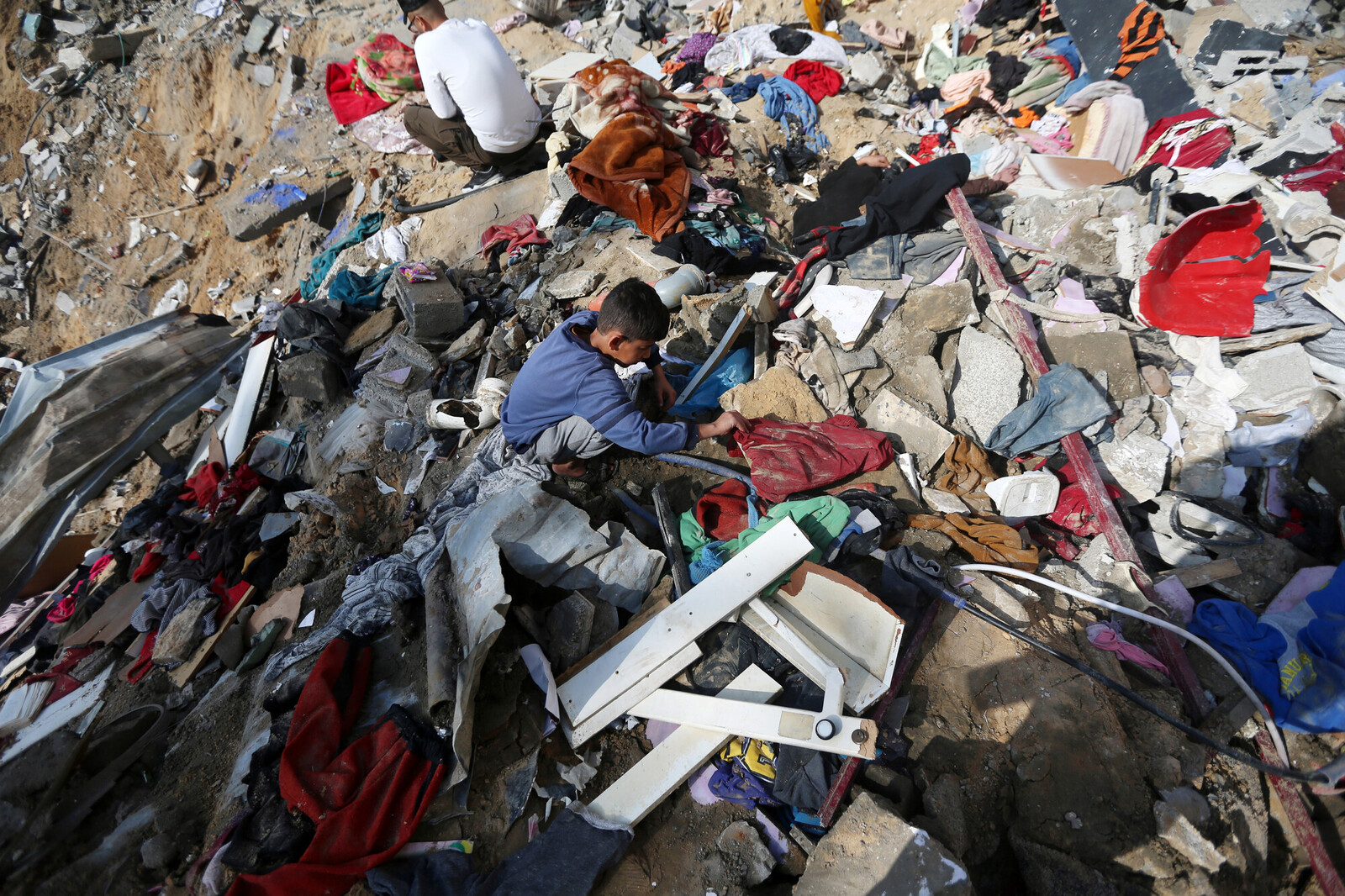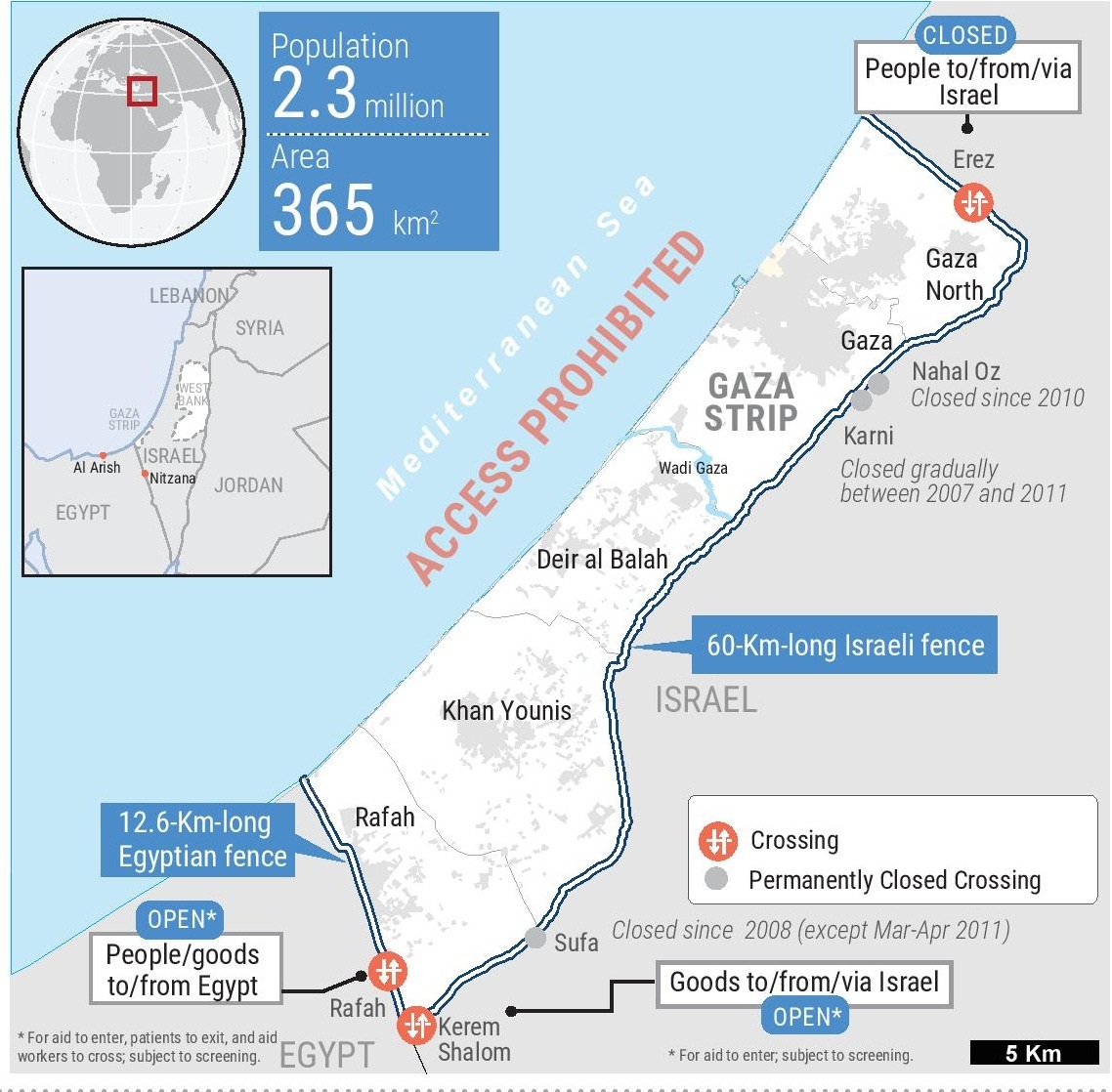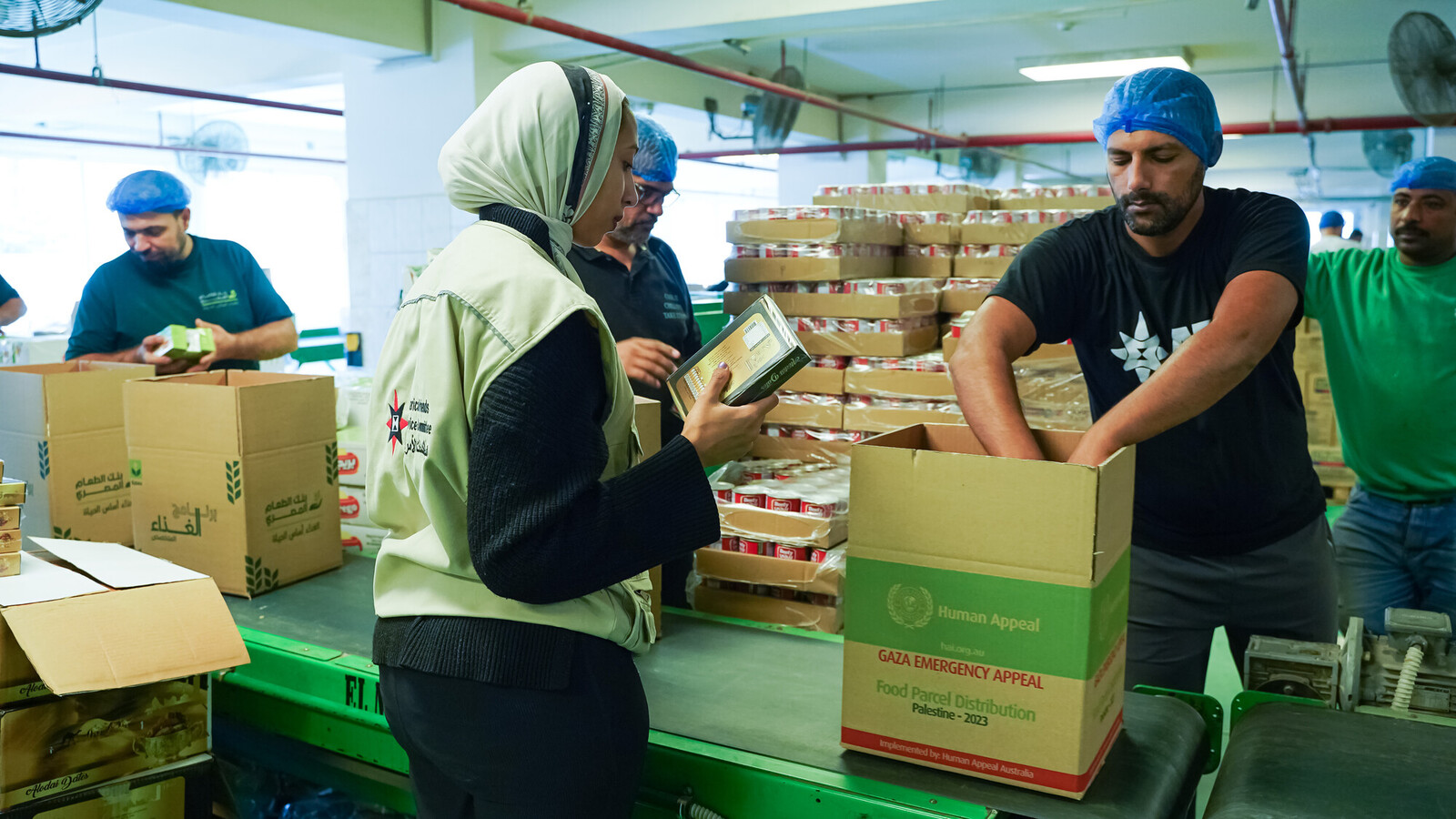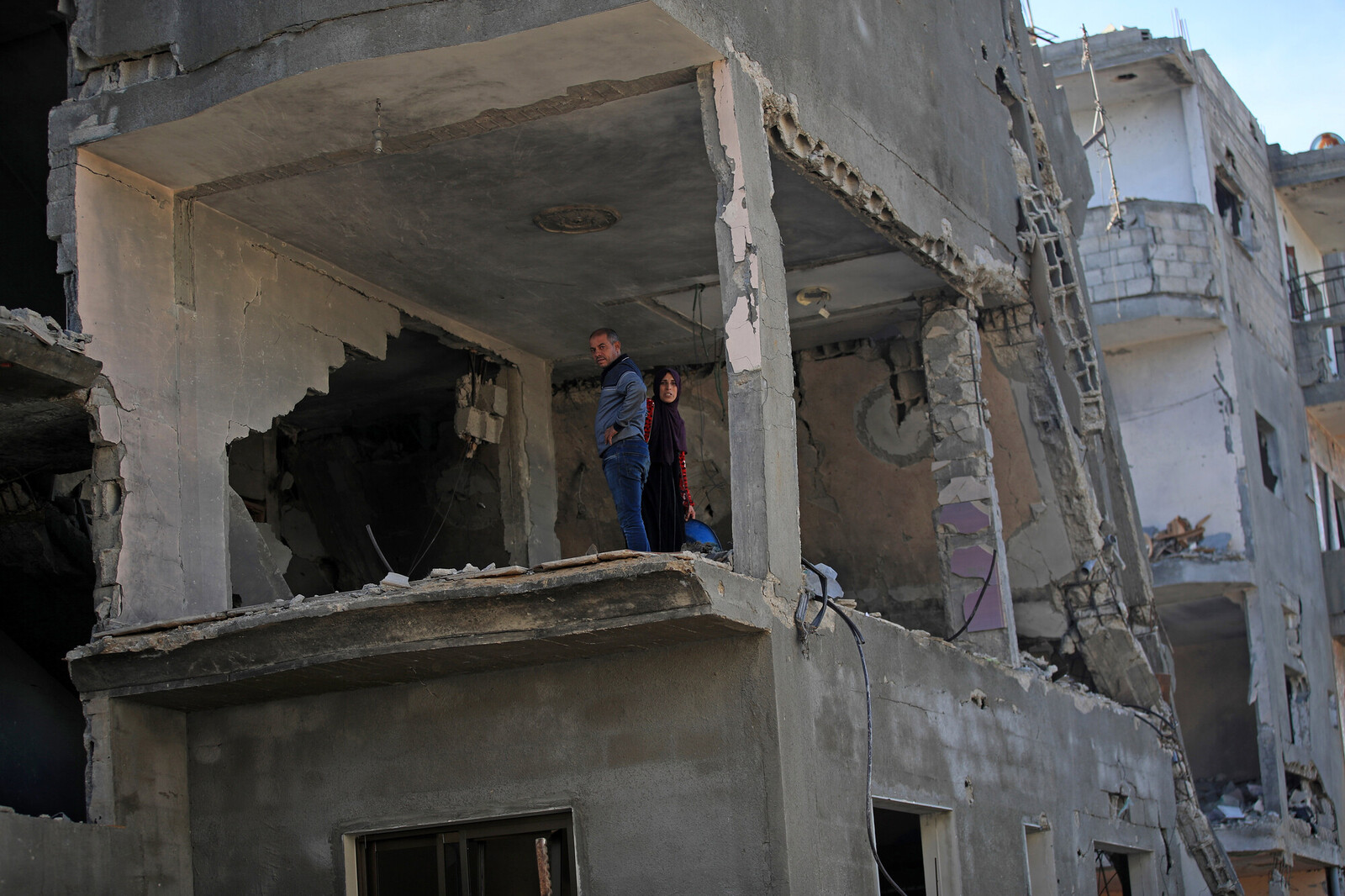
A child picks through rubble in Gaza. Mohammed Zaanoun
AFSC has offices and staff in Jerusalem, Gaza, the West Bank, and Jordan. Today, we are providing humanitarian relief to Palestinians in Gaza and the West Bank—as we advocate for a permanent cease-fire and protection for the Palestinian people.
Here’s the latest from our Middle East team on the situation facing Palestinians and how AFSC is responding to the crisis.
By the numbers: The human toll since Oct. 7
GAZA
• 22,438+ killed
• 10,000+ buried under the rubble
• 57,614 injured
• 1.93 million displaced
• 6,000+ arrested
• 355,000 homes and other structures partially or completely destroyed
WEST BANK
• 324 killed
• 4,040 injured
• 1,208 displaced
• 4,800 arrested
• 365 homes and other structures partially or completely destroyed
Sources: Gaza Ministry of Health, UNOCHA

Credit: UN OCHA
The humanitarian situation in Gaza
After 88 days, 65,000 tons of explosives, the number of Palestinians killed has almost reached 23,000—70% of whom are women and children. The situation in Gaza is catastrophic and continues to worsen exponentially. The total population of Gaza—2.3 million Palestinians—is in urgent need of help. If we want to save something of Gaza, we need a total cease-fire, the immediate opening of all crossings and the unconditional access of humanitarian aid and commercial goods, and the restoration of all services (water, electricity, and fuel access) that have been cut off by Israel.
High risk of ethnic cleansing: During this week, heavy Israeli bombardment from air, land, and sea have continued across most of the Gaza Strip. Intense ground battles have been reported in refugee camps in central Gaza and the southern town of Khan Younis, and heavy strikes have been reported in Gaza City. Most of the Middle Area (Beit Lahiya, East of Khan Younis, Maghazi, Deir El-Balah, and Nouseirat), and east of Rafah in the south have been under heavy Israeli bombardment and shelling, with more Israeli Army soldiers deployed. After the obliteration of the north of Gaza, Israel’s destruction of the Middle area and the Southeast area of Gaza will make the eastern of Gaza completely unhabitable, pushing people into a small area (Rafah) and finally into forced expulsion. In line with this approach, Prime Minister Benjamin Netanyahu announced on Dec. 31 that Israel will re-occupy the Philadelphi corridor comprising the Gaza-Egypt border. Accordingly, Israel is bulldozing Rafah’s farmland as part of its plan to create a buffer zone with Egypt.
More forced displacement and severe overcrowding: According to UNRWA, 1.9 million people, or nearly 85% of the total population of Gaza, are estimated to be internally displaced. That includes some who have been displaced multiple times, as families are forced to move repeatedly in search of safety.
Rafah is now the main refuge for those displaced. It is estimated that over 1.3 million internally displaced people are in Rafah alone, squeezed into an extremely overcrowded space. People are sleeping in the streets, out in the open. Some of them have not been able to even follow the evacuation orders. The severe overcrowding—together with the impeded access to health and medical supplies, the lack of food and clean water in particular, and poor living conditions—has increased the risk of death to many.
Due to the extreme overcrowding in Rafah city, the roads are so congested that trucks cannot operate, further hampering efforts to distribute humanitarian aid.
Hunger and starvation: People are starving to death. The risk of famine increases each day as the conflict continues and restricted humanitarian access persists. A Famine Review Committee (FRC) was activated due to evidence that acute food insecurity in Gaza has surpassed Phase 5 (catastrophic threshold). The committee stated that it is imperative to halt the deterioration of health, nutrition, food security, and mortality situation through the restoration of health, water, sanitation, and hygiene services. In addition, the FRC has called for the cessation of hostilities and the restoration of humanitarian space for delivering multi-sector assistance, noting these were vital first steps to eliminate any risk of famine.
Despite 2.2 million people urgently needing food assistance each day, the average daily assistance in the last week of December reached only 8% of the targeted people in need.
Lack of humanitarian access: We need unconditional humanitarian access to Gaza now. Today, there is just a fraction of the needed food supplies coming in. Israel’s restrictions on humanitarian access to deliver aid to Gaza are increasing—contrary to what was expected and what is needed. Before Oct. 7, about 500 trucks of aid would enter Gaza daily, which was insufficient. Since Oct. 21, only an average of 100 trucks per day have been allowed to enter daily.
The communications and fuel shutdown continues to significantly hinder the aid community’s efforts to assess the full extent of needs in Gaza and to adequately respond to the deepening humanitarian crisis.
Access of humanitarian aid to the area north of Wadi Gaza is extremely challenging. The U.N. and other humanitarian actors have been unable to deliver urgently needed life-saving humanitarian assistance north of Wadi Gaza for three days due to access delays and denials, as well as active conflict. This includes medicines that would have provided vital support to more than 100,000 people for 30 days, as well as eight trucks of food for people facing life-threatening food insecurity.
Buildings and infrastructure destroyed: Extensive bombardment has resulted in the destruction and damage of almost all buildings, alongside widespread damage to roads and essential infrastructure such as power systems and distribution networks, and water storage tanks, pipes, supply networks, and drainage channels. This has prevented access to services and infrastructure critical to meet basic needs.
It is estimated that 70% of infrastructure have been either damaged or completely destroyed, including protected infrastructure like hospitals, schools and religious buildings, mosques and churches. Also, over 200 archeological sites have been destroyed out of 325 registered ones.
A health system that has collapsed: Twenty-three out of Gaza’s 36 hospitals are not functioning, according to the World Health Organization. Some hospitals in the north have been reactivated after being for weeks under siege, raided, and health care personnel, patients, relatives, and people taking shelter in the hospitals themselves or in their surroundings have been killed, beaten, and detained. Though these hospitals have been offering some services, they still face many challenges as only a minimum level of supplies has been able to reach the facilities after the Israeli army has withdrawn. Personnel are exhausted and have an urgent need for fuel, food, and drinking water. They face a shortage of medical staff as well as a lack of medical supplies such as anesthesia, antibiotics, and pain relief medicines.
The nine partially functional health facilities in the south are operating at three times their capacity while facing critical shortages of basic supplies and fuel.
Rising public health concerns: The lack of medical supplies, clean water, food, and other essential supplies—combined with poor living conditions, severe overcrowding in shelters, and the disruption of health, water, and sanitation systems—have increased the risk of communicable diseases. There are grave concerns over waterborne diseases due to water consumption from unsafe sources. Diarrhea and respiratory conditions are alarming. And there are also rising cases of influenza, chicken pox, meningitis, jaundice, impetigo acute respiratory infections, skin infections, and hygiene-related conditions like lice.
By Dec. 12, the Ministry of Health had documented 360,000 cases of infectious diseases in shelters, noting that the actual number is believed to be higher. It has also identified 14 diseases with epidemic potential and fears an outbreak due to the huge shortage of medicines and vaccinations to mitigate infectious diseases.
Vulnerable groups in difficult conditions: Several groups are especially vulnerable due to the lack of proper shelter, health, and basic services. That includes people with disabilities; women who are pregnant, have recently given birth, or are breastfeeding; people who are recovering from injuries or surgeries; seniors; children, especially newborns; and those with compromised immune systems.

In Cairo, AFSC staff and partners pack boxes of emergency food to deliver to displaced people in Gaza. Maryam Azzam
AFSC’s emergency relief efforts
In Gaza, AFSC has provided emergency relief to displaced people in the Khan Yunis and Rafah regions of Gaza. Over the past week, our staff have served hot meals from open-air kitchens to displaced people living outside of shelters, reaching around 2,000 people a day.
Our staff, working with partners, have also distributed in recent weeks:
• 250 parcels of vegetables to families living in tents, reaching more than 2,500 people.
• 502 food parcels for 3,600 people with easily prepared items such as luncheon meat, canned cheese, and jam that provide enough to feed a family for two days.
• 770 meals of rice and meat for families, serving 2,370 people.
• 500 family hygiene kits with items such as soap, shampoo, toothbrushes, toothpaste, hairbrushes, nail clippers, ear cotton, wipes, underwear, women's hygiene products, and other sanitary supplies.
We are also sending additional aid through Egypt into Gaza when Israeli authorities allow it. So far, we have procured two trucks of food and one truck of medicine. Now we’re procuring three more trucks with blankets and winter clothes for families.
Read more about AFSC’s emergency relief.
In the West Bank, Palestinians are increasingly facing arbitrary killings and detentions, home demolitions, daily Israeli army raids, and other human rights violations. Those released from detention have reported the violations committed against detainees inside Israeli prisons, including systematic torture and abuse and the forcible disappearance of Gazan detainees. Since the aggression began, the Israeli authorities have amended military orders and laws to facilitate the prolonged detention of Palestinians without due legal process. The International Committee of the Red Cross and lawyers are being denied visits to detainees from Gaza.
Over 150,000 workers from the West Bank, previously employed in Israel and settlements, have lost their jobs due to firing or restricted crossings.
In recent weeks, AFSC has supported 168 patients from Gaza and their relatives who were receiving treatment in Jerusalem and were forced to relocate to Ramallah during the war. We assisted patients with medical needs and winterization items. Working with partners, we are now providing patients and their families hot meals daily.
How you can help
Contact Congress today: Urge your representatives to call for a total cease-fire and humanitarian access to Gaza.
Give to AFSC’s Gaza emergency response: Your donation will bring humanitarian relief and support ongoing efforts to stop the violence, address its root causes, and build conditions for peace.
